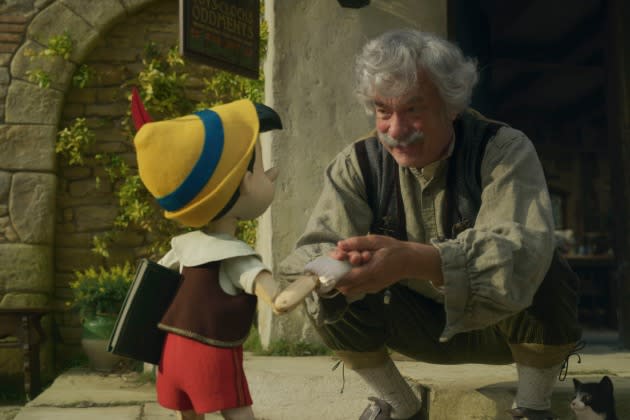‘Pinocchio’ Review: Robert Zemeckis Offers a Lavish but Hollow Remake of the Disney Classic
- Oops!Something went wrong.Please try again later.

At this point, complaining about Disney’s deathless drive to cannibalize its entire library of animated classics into live-action remakes can feel as futile as complaining about capitalism itself. The studio has immense IP resources to exploit, a hungry well of content to fill, and a commercial imperative to introduce new generations of kids to the characters they’ll soon be expected to recognize on merch and in theme parks. And in truth, the studio could be doing a lot worse with these trawls through the archives. Once in a while genuine inspiration strikes (as it did with the gothy, revisionist “Maleficent,” or Jon Favreau’s visually inventive “The Jungle Book”), and even the least-fortunate of these remakes have mostly just been forgettable.
And yet something feels particularly unnecessary about the Robert Zemeckis-directed “Pinocchio,” which revisits nearly every beat of the 1940 animated classic just months before Guillermo del Toro is set to unveil what appears to be a wildly different interpretation of Carlo Collodi’s nineteenth century source material, and two years after Matteo Garrone offered his own Oscar-nominated spin. Roping a game Tom Hanks into the fold as the kindly woodworker Geppetto, and employing countless digital artisans to re-create the iconic character design of the protagonist to eerily lifeless effect, “Pinocchio” is a lavish yet hollow retread that will surely give the original a boost when it arrives on Disney+ this weekend. Asking anything more from it than that is, apparently, a request too extreme.
More from Variety
Wes Anderson's Stunning 'Asteroid City' Trailer Unites Tom Hanks, Scarlett Johansson and Aliens
Mike Mignola and Lemony Snicket Create Reimagined, Gothic 'Pinocchio' (EXCLUSIVE)
Swelling the running time from the original’s lean 88 minutes to a slightly sodden 111, Zemeckis’ “Pinocchio” does add a few novel wrinkles to this well-worn tapestry. There’s a new anthropomorphic character: a sassy seagull named Sofia, voiced by Lorraine Bracco. Lyricist Glen Ballard and composer Alan Silvestri have composed several largely middling new songs, although most of the original’s key tunes survive in some form. Newcomer Kyanne Lamaya is the best addition, playing a dancer-turned-puppeteer who forges a bond with Pinocchio. And perhaps most notably, Geppetto has been given an expanded backstory involving a dead son and a wife, an unnecessary crutch for an actor who can elicit pathos as effortlessly as Hanks.
Aside from that, the film rarely strays too far from its blueprint. The story is again narrated by Jiminy Crickett, voiced by Joseph Gordon-Levitt in a capable approximation of Cliff Edwards. Taking refuge in Geppetto’s workshop, he watches as the old man’s wish-upon-a-star summons the Blue Fairy (Cynthia Erivo), who gives life to Geppetto’s puppet creation Pinocchio, and appoints Jiminy to serve as his provisional conscience. From here, Pinocchio (voiced by Benjamin Evan Ainsworth) will make an ill-fated trip to school, grow disillusioned with the life of an actor, learn a few traumatizing lessons about trustworthiness and honesty, and of course, do battle with a whale.
Zemeckis’ “Pinocchio” works best in its opening act, when the director mostly mimics the original’s pacing and allows the camera to stay relatively still in Geppetto’s workshop. (One can even forgive the scene’s bizarre cameos from various other Disney properties, attributing it to cheekiness rather than cynicism.) The real trouble, however, arises when he feels the need to go bigger, which he will do again and again throughout the rest of the film. No longer simply a mean-looking sperm whale, Monstro is now a fully-fledged sea monster, with gruesome patchwork skin and flopping Lovecraftian tentacles. Once a skeezy carnival, Pleasure Island has now become a full-on Bizarro Disneyland with flying gondolas, candy mountains and spectral, fiery-eyed apparitions carting off the transformed children to a life of servitude. (Although the beer and cigars have disappeared from this scene, full credit to Zemeckis for refusing to tone down its essential nightmarishness.) And the less said about the Keegan-Michael Key-voiced Honest John – turned from the original’s delightfully slithery concoction into a blur of ungainly visual tics and groaner pop culture references – the better.
For decades Zemeckis has been as instrumental as any other living filmmaker in blurring the lines between animation and live-action, and it’s easy to admire some of this film’s individual flourishes: whether it’s the perfect raindrops trickling down a glass jar that Jiminy Cricket is imprisoned in, the camera darting through the village streets, or even just Pinocchio’s shambling yet believably weighted gait. But as with so many of the director’s previous CGI extravaganzas, all the meticulous surface detail in the world can’t compensate for the core emptiness of the film’s digital creations. Pinocchio’s naïveté, Jiminy Cricket’s avuncular haplessness, even Figaro the cat’s mischief – all have lost a noticeable degree of humanity and soul in the transition from ink to pixels. There may be no strings on this Pinocchio, but there isn’t much of a heart in him either.
Best of Variety
Sign up for Variety’s Newsletter. For the latest news, follow us on Facebook, Twitter, and Instagram.
